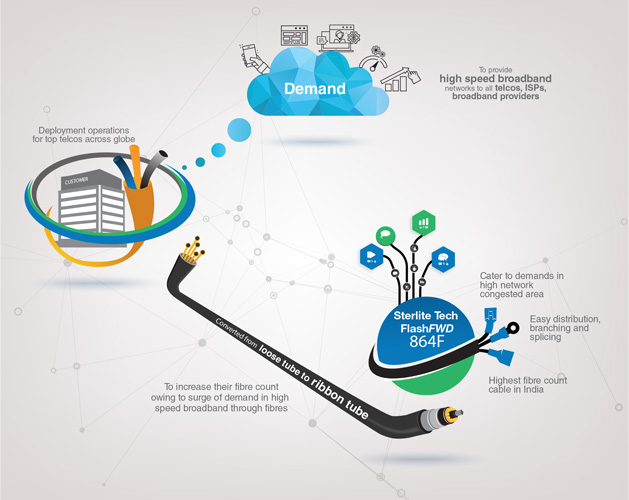We discuss the following topics in this blog:
- Dense network capability that enables high speeds.
- What is FlashFWD?
- 5G Opportunities for Telecom Operators
In addition to these topics, we shall also be answering the following FAQs:
- What is WiFi?
- What is an Optical Fibre Cable?
Contents
How Sterlite Tech Addressed High-Speed Requirement?
With the global transformation towards web scale networks that enables 5G and Internet of Things technologies, Sterlite Tech was getting multiple queries from its customers in US, EMEA and India for a new, dense network capability that enables extremely high data speeds and low response time. Here is a case study on how Sterlite Tech addressed this requirement through its FlashFWD technology.
Addressing this requirement and to accommodate multiple cable needs wherein telecom service providers could cater to their customers demands, Sterlite Tech developed the innovative 5G Ready Network Solution named FlashFWD with 864 fibre count to optimise cable usage, lower TCO, provide future-proofing, and address the needs for effective utilisation of networks.
What is FlashFWD?
In its 864F version, FlashFWD features 6 ribbon tubes to address demands of customers in high network congested areas in the present and in the future. The USPs of the cable includes easier distribution, branching and splicing of fibres in the form of ribbon tubes as compared to loose tube design. 864F bre count cable proved as the first step towards growing needs of high data demand in India.
Our customers reaped its benefits of armoured designs and efficient use of limited duct space due to high fibre count. With special low-bend sensitivity, the cable provides high bandwidth and excellent communication transmission property. The all new FlashFWD category is from NABL Certified plant and complies with the latest global standards of IEC.60794 series, ANSI/ICEA S-87-640, Telcordia GR-20, ITU-T Recommendations, CPR approved for LSZH versions.
5G Opportunities for Telecom Operators
In the wake of growing awareness around Internet of Things (IoT) and the use cases it presents to global businesses and consumers, 5G will open a new era of opportunities for telecom operators and ecosystem partners world-wide. Internet of Things is also likely to provide a $15 billion market opportunity for Indian businesses by 2020, according to officials at Department of Telecom (DoT). Combine this with the unprecedented growth in the number of smartphone users in India, which is expected to overtake the US in terms of smartphone shipment by 2019. Analysts are optimistic that India will hold around 15% of the world’s smartphone market share by that period – Indian consumers are ready for 5G
With the global transformation towards web scale networks that enables 5G and Internet of Things technologies, Sterlite Tech was getting multiple queries from its customers in US, EMEA and India for a new, dense network capability that enables extremely high data speeds and low response time.
Sterlite Tech Academy
To address the deployment requirements and to match global benchmarks for this ribbon cable technology, Sterlite Tech also provided a series of technical engagements in order to increase customer’s knowledge and awareness through its Sterlite Tech Academy. The Academy has specially designed modules to create Smarter Network Professionals equipped with the necessary skills to plan, deploy and maintain all kinds of fibre networks. The course modules are structured keeping in view the market needs and the skill sets that are the need of the hour.
FAQs
What is WiFi?
Put simply, WiFi is a technology that uses radio waves to create a wireless network through which devices like mobile phones, computers, printers, etc., connect to the internet. A wireless router is needed to establish a WiFi hotspot that people in its vicinity may use to access internet services. You’re sure to have encountered such a WiFi hotspot in houses, offices, restaurants, etc.
To get a little more technical, WiFi works by enabling a Wireless Local Area Network or WLAN that allows devices connected to it to exchange signals with the internet via a router. The frequencies of these signals are either 2.4 GHz or 5 GHz bandwidths. These frequencies are much higher than those transmitted to or by radios, mobile phones, and televisions since WiFi signals need to carry significantly higher amounts of data. The networking standards are variants of 802.11, of which there are several (802.11a, 802.11b, 801.11g, etc.).
What is an Optical Fibre Cable?
An optical fibre cable is a cable type that has a few to hundreds of optical fibres bundled together within a protective plastic coating. They help carry digital data in the form of light pulses across large distances at faster speeds. For this, they need to be installed or deployed either underground or aerially. Standalone fibres cannot be buried or hanged so fibres are bunched together as cables for the transmission of data.
This is done to protect the fibre from stress, moisture, temperature changes and other externalities. There are three main components of a optical fibre cable, core (It carries the light and is made of pure silicon dioxide (SiO2) with dopants such as germania, phosphorous pentoxide, or alumina to raise the refractive index; Typical glass cores range from as small as 3.7um up to 200um), Cladding (Cladding surrounds the core and has a lower refractive index than the core, it is also made from the same material as the core; 1% refractive index difference is maintained between the core and cladding; Two commonly used diameters are 125µm and 140µm) and Coating (Protective layer that absorbs shocks, physical damage and moisture; The outside diameter of the coating is typically either 250µm or 500µm; Commonly used material for coatings are acrylate,Silicone, carbon, and polyimide).
An optical fibre cable is made up of the following components: Optical fibres – ranging from one to many. Buffer tubes (with different settings), for protection and cushioning of the fibre. Water protection in the tubes – wet or dry. A central strength member (CSM) is the backbone of all cables. Armoured tapes for stranding to bunch the buffer tubes and strength members together. Sheathing or final covering to provide further protection.
The five main reasons that make this technology innovation disruptive are fast communication speed, infinite bandwidth & capacity, low interference, high tensile strength and secure communication. The major usescases of optical fibre cables include intenet connectivity, computer networking, surgery & dentistry, automotive industry, telephony, lighting & decorations, mechanical inspections, cable television, military applications and space.













